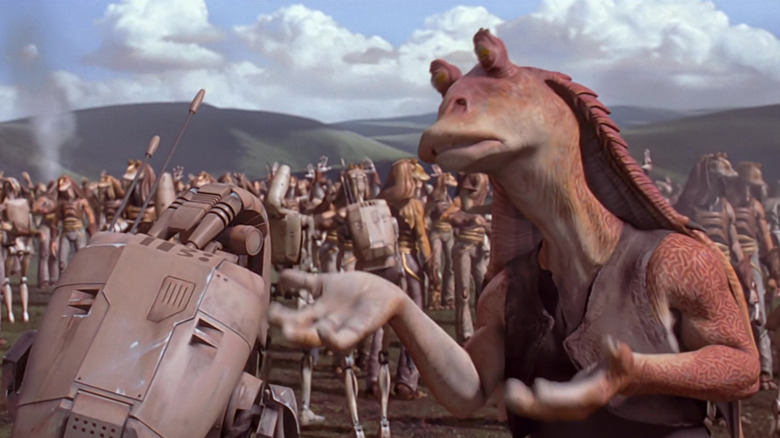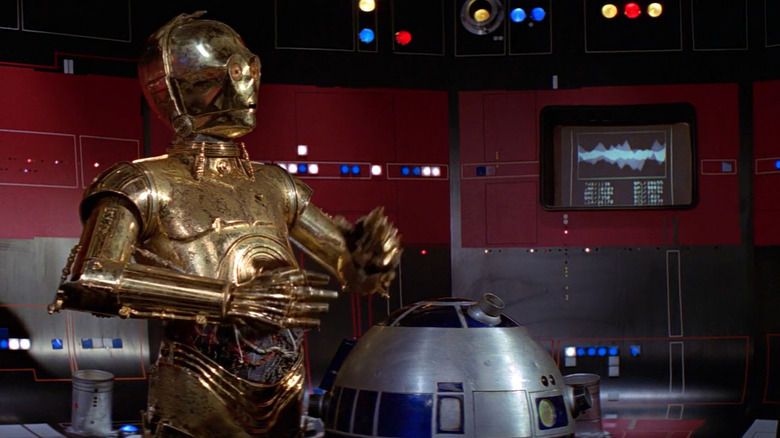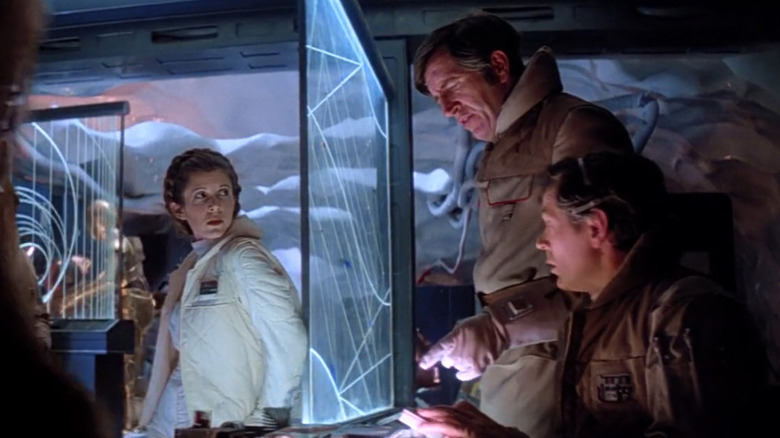An Easter Egg From George Lucas' First Sci-Fi Movie Appears All Over The Star Wars Franchise
It's worth pausing to note that George Lucas has never directed a feature film that is set in the present. "American Graffiti," released in 1973, takes place in 1962. His many "Star Wars" movies, although containing starships and androids, are similarly set "a long time ago, in a galaxy far, far away." In all these cases, Lucas sees the past as an idealized time, when life was simpler and more pleasant. In the case of "American Graffiti," the past was the calm before the storm, back when life was nothing but potential energy and the future was ready to be explored. In the case of the "Star Wars" films, it was a time when brave heroes rose up to battle fascism and evil empires regularly tumbled.
The future, Lucas feels, is a dour time, and nothing good will happen to humanity when we get there. At the end of "American Graffiti," for instance, on-screen chyrons note that several of the characters died tragically, one in a car wreck and another in Vietnam, while others now live boring, adult lives that are far from their teenage dreams. Nowhere, however, is the future more bleak than in Lucas' 1971 feature directing debut "THX 1138," a hard-edged dystopian work and the only film Lucas has helmed that's set beyond the modern day.
"THX 1138" takes place in an unstated year where sex and reproduction have been banned by the government. Everyone lives caged in glowing white rooms and their names have been replaced with letter-and-number designations. Emotions are verboten as well, and everyone is deadened with drugs. Robert Duvall plays THX 1138, a barely-alive wonk who works at a factory that builds the fascist police robots seen in every hallway. People worship a state-sponsored Messiah figure called OMM 0000, implying that even spirituality has been commodified.
Lucas is clearly fond of "THX 1138," so much so that he has revisited the title many times throughout his career. Attentive "Star Wars" fans will likely have spotted the letters THX or the numbers 1139 hiding in the background of many of his movies.
The title of TXH 1138 is hidden in the background of multiple Star Wars scenes
Most visibly, when Lucas founded his movie theater audio company, he decided to call it THX. Children of the late 1980s and early 1990s will likely recall the THX "Deep Note" trailer in theaters, wherein the loudest sound you ever heard was blasted directly in your face. More subtly, however, Lucas liked to hide it in his films the way Al Hirschfeld might hide a "Nina."
In "Star Wars: Episode IV — A New Hope," for example, there is a scene where Luke Skywalker (Mark Hamill) and Han Solo (Harrison Ford), in disguise as Imperial stormtroopers, have infiltrated the Death Star. As part of their charade, they pretend to lead their friend Chewbacca (Peter Mayhew) to a prison cell. Hence, at one point, they are questioned by an imperial officer where they are taking their companion. Luke, in character, claims to be making a prisoner transfer from Cell Block 1138.
A few scenes later (as seen in the photo above), the droids C-3PO (Anthony Daniels) and R2-D2 (Kenny Baker) are in a control room on the Death Star. If you look very closely, the numbers THX-1138 are visible on a video monitor on the wall beside them.
Likewise, in Irvin Kerchner's follow-up "Star Wars: Episode V — The Empire Strikes Back," there is a brief mention of an officer, designated Rogue 11, being sent to station 3-8. That one is easy to miss. Also hard to see is the lettering on the side of Princess Leia's (Carrie Fisher) helmet in Richard Marquand's "Star Wars: Episode VI — Return of the Jedi." In that film, Leia, wearing a disguise, infiltrates the lair of Jabba the Hutt (Larry A. Ward) in an attempt to free a captured Han Solo from captivity. Her disguise helmet has symbols that look like "1138" printed on the side. It's designed in such a way, though, as to better resemble alien lettering.
There are many other 1138 references besides
If you scroll back to the top of this article, you'll see an image of the Gungan Jar Jar Binks (Ahmed Best) grappling with a battle droid in a scene from Lucas' own 1999 box office hit "Star Wars: Episode I — The Phantom Menace." You can see some alien script on the droid's back, and the letters look like the number "1138." Another battle droid has a similar set of numbers on its jetpack in a scene from "Star Wars: Episode II — Attack of the Clones," making the designation an official part of "Star Wars" canon.
Lucas hasn't directed a film since "Star Wars: Episode III — Revenge of the Sith" in 2005, so any further "Star Wars" references to "1138" have been made by fans who noticed the pattern and wanted to keep them alive. As such, there are many, many other "THX 1138" references in more recent "Star Wars" media. In the "Andor" episode "Reckoning," for instance, there is a ship with the numbers 1138 on its side. Similarly, in the "Star Wars: Skeleton Crew" episode "We're Gonna Be in So Much Trouble," a droid notes, while standing next to a vault in a mint, that there are 1,139 vaults in total. Minus the one we're seeing, that means there are 1,138 of them.
And that's not counting the multiple animated shows, novels, comic books, and video games that have playfully included THX and/or 1138 in some way. Heck, there are even 1138 references on the "Star Tours" ride at Disneyland in California. Once you start noticing them, you'll never stop.


